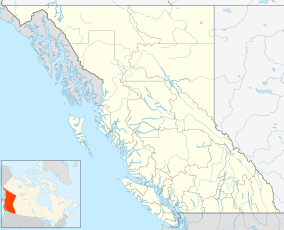Seton Portage Historic Provincial Park facts for kids
Quick facts for kids Seton Portage Historic Provincial Park |
|
|---|---|
|
IUCN Category II (National Park)
|
|
| Location | Seton Portage, British Columbia, Canada |
| Nearest city | Lillooet |
| Area | 0.7 ha (1.7 acres) |
| Established | March 29, 1972 |
| Governing body | BC Parks |
Seton Portage Historic Provincial Park is a special park in British Columbia, Canada. It's located in the community of Seton Portage. This park was created on March 29, 1972. It celebrates the spot where British Columbia's very first railway was built!
Contents
Park Location and Size
This park is found at the western end of Seton Portage. It sits between Seton Portage Road and the CN Rail tracks. Just past the tracks is the Seton River. This river flows from Anderson Lake into Seton Lake. The park has many pine trees and light plants, typical for this area.
Seton Portage Historic Provincial Park is very small. It covers only 0.7 hectares (1.7 acres). This makes it the smallest provincial park in all of British Columbia! It is also one of the smallest protected areas managed by BC Parks.
History of the First Railway
Building the Railway in 1861
A railway, about 3 kilometres (1.9 mi) long, was built here in 1861. It was used to move goods for miners. These miners were heading to the Fraser goldfields. The area was an important stop on their journey.
The railway was unique. Horses pulled carts uphill, a small rise of only 15 meters. Then, gravity helped the carts go downhill. This railway was known as Dozier's Way. It was named after its owner, Carl Dozier.
The Old Roadbed Today
Today, you can still see parts of the old railway roadbed. It follows much of Portage Road. This road goes from Nkiat to the main part of Seton Portage. Nkiat and Slosh are First Nations villages. They were once gold rush ports called Wapping and Flushing.
The early railway only ran for a few years. Even though it was used for some travel, the area became less important. Other routes, like the Douglas Road, were eventually forgotten.
How Seton Portage Got Its Name
The area got its current name, Seton Portage, in 1858. This was a big year, marking 100 years since the gold rush began. It was also when the colony was created. Before 1858, it was called the Short Portage. It was also sometimes just called "Seton" along with Shalalth.
The Lillooet Cattle Trail also followed this route. It was built like the Douglas Road. There was even a clever walkway along the cliffs of eastern Seton Lake. But this trail was hard to use and was later abandoned. In 1915, the Pacific Great Eastern railway connected Seton communities to Lillooet.
Park Creation and Visitor Centre
In 1972, the British Columbia Railway gave the land to BC Parks. This is how Seton Portage Historic Provincial Park was created. Later, an old train car called a caboose was placed near the park. It used to be a tourist information centre for the community. However, it has not been used as an information centre since November 2012.
Park Facilities and Access
This park does not have places for camping. It also does not have day-use facilities like picnic areas.
You can no longer take a passenger train directly to this spot. Only a local train from Lillooet, on the Canadian National Railway line, still runs. To get to Seton Portage by road, you must use the challenging Mission Mountain Road. The Anderson Lake Highline Road is even more difficult. These are the only roads connecting Seton Portage and Shalalth to the outside world.


